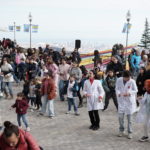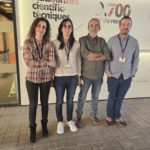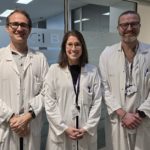
Dr Jordi Surrallés, Director of Sant Pau Research Institute (IR Sant Pau), has been recognised by the College of Biologists of Catalonia for his outstanding career and contributions to biology and biomedical research. This annual award honours professionals who have made significant contributions to scientific knowledge and its application in society.
This distinction is part of the Biologist’s Day Awards, an initiative launched by the College of Biologists of Catalonia in 2017. Held annually on 25 April, the event pays tribute to professionals in the field of biology. The date marks the anniversary of the publication of the DNA structure by James Watson and Francis Crick in 1953, a landmark moment in biological history. The awards acknowledge individuals or institutions that have significantly enhanced the prestige of the profession, either through their scientific achievements or their service to the field of biology.
The College’s Governing Board granted this award to Dr Surrallés in recognition of his ongoing research into the mechanisms that maintain genome stability and protect against disease, cancer, and ageing. He was also commended for his ability to translate this knowledge into innovative therapeutic and diagnostic strategies in oncology, precision medicine, and rare diseases, such as Fanconi anaemia.
Dr Surrallés graduated in Biological Sciences from the Autonomous University of Barcelona (1990) and obtained his PhD in Genetics (1994). He then expanded his postdoctoral experience in the Netherlands and Finland before establishing his own research team at the Autonomous University of Barcelona, where he serves as a Professor of Genetics. In 2017, he was appointed Head of the Genetics Service at Sant Pau Hospital and currently serves as Scientific Director of IR Sant Pau. He also leads research groups at both IR Sant Pau and the Centre for Biomedical Research in Rare Diseases (CIBERER). Since 2008, he has held the prestigious ICREA Academia recognition.
Throughout his career, Dr Surrallés has led over 60 competitive research projects funded by public and private institutions worldwide. He has also been involved in clinical trials, patents, and collaborations with biotechnology and pharmaceutical companies. In addition, he has delivered dozens of lectures at international conferences, published nearly 150 scientific articles, and supervised 20 doctoral theses.
Alongside Dr Jordi Surrallés, the College of Biologists of Catalonia has recognised seven other professionals in the 2025 Biologist’s Day Awards. Among them is Eloïsa Matheu de Cortada, an expert in animal acoustic communication and soundscapes, and founder of the Alosa record label. Another recipient is Dr Alfonso Valencia Herrera, a PhD in Biochemistry and Molecular Biology, an ICREA Research Professor, and Director of the Life Sciences Department at the Barcelona Supercomputing Centre.
In the field of environmental management, the award has been given to Ramon Jordana i de Simon, a graduate in Biological Sciences from the University of Barcelona and former Deputy Director-General for Hunting Activities and Inland Fisheries in the Catalan public administration. In the field of microbiology, Dr Jordi Barbé Garcia has been recognised. He is the Rector’s Commissioner at the Autonomous University of Barcelona for secondary education relations and is known for his significant contribution to teaching.
In the area of biomedical research, the College has awarded Dr Eduard Batlle Gómez, a researcher specialising in colorectal cancer and metastasis at the Institute for Research in Biomedicine (IRB Barcelona), for his studies on the relationship between intestinal stem cells and cancer development. In the field of bio-entrepreneurship, Salvador Garcia López, founder of “Sanitat Vegetal”, has been recognised for his work in integrated pest management in green spaces and gardening. Finally, science communicator Pere Estupinyà Giné has been honoured for his work in making biology and science accessible to the general public.
Through these awards, the College of Biologists of Catalonia highlights the contributions of these professionals across various areas of biology, from research and education to environmental management and science communication.






















